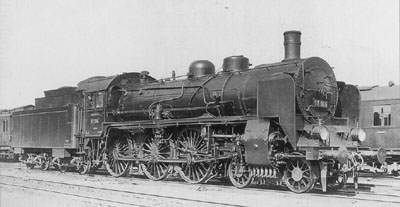| |
BR 17.0-1
From the technical service of the directors of Kassel, Elberfeld, Erfurt and Frankfurt of the Preußisch-Hessischen Staatsbahn became the need of a powerful express train locomotive. The Prussian railways decided to built a steam engine with three coupled axles. Schwartzkopff delivered in 1910 two prototype locomotives which got the indication S8 (from 1912 S10). But the locomotives did not satisfy the expectations, as a result the construction had to changed. The frame was modified, so that the driving transmission was much more accesible. After two additional changes (the boiler pressure was raised from 12 bar to 14 bar), the locomotive was satisfying. The locomotives got from 1911 the indication S10. The S10 was capable of pulling a train of 390 ton on a flatland with a speed of 100 km/h, and on a hillside of 10‰ pulling a train of 360 ton with a speed of 50 km/h. Between 1911 and 1914 there are 200 steam engines of type S10 built, they had mainly their service in express trains on mainlines.
In service at the DRG
 | | Locomotive BR 17 006 |
The DRG took over 135 steam engines and gave them the indication BR 17.0-1 with the numbers: 17 001 up to 17 135. The S10 was set aside in 1935 also due to the high coal consumption. Only the locomotives 17 039, 102 and 107 were preserved until the end of the fourties and begin fifties. These locomotives were used as resistance locomotives in the LVA Grunewald.
| Axle layout: |
2'C h4 |
| In service: |
1911-1914 |
| Diameter driving wheels: |
198 cm |
| Diameter carrying wheels: |
100 cm/- |
Lengte over de buffers
(met tender pr. 2'2' T31,5): |
20,750m |
| Top speed: |
110 km/h |
| Boiler pressure: |
14 bar |
| Weight: |
77,2 t |
|
